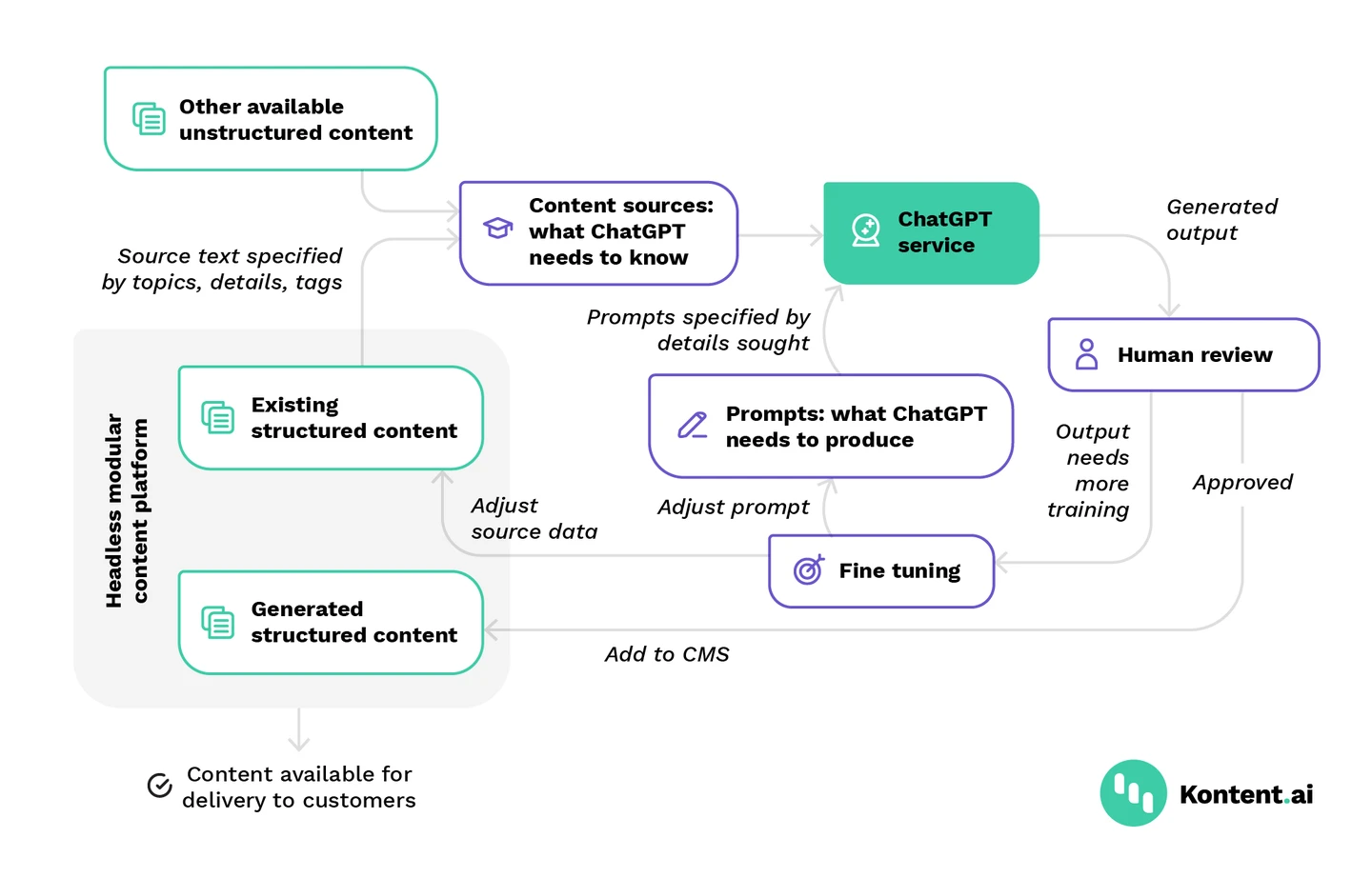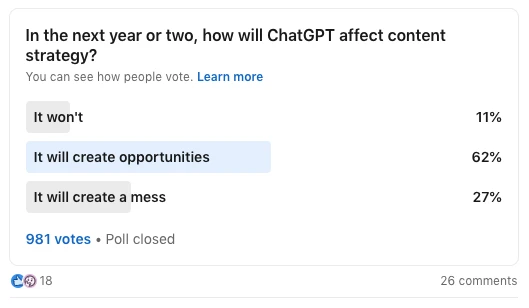Content strategy using ChatGPT with a headless CMS
How does ChatGPT fit into content strategy and headless content management? The way that enterprises implement ChatGPT will determine the value they derive from it.

Published on Feb 2, 2023

How does ChatGPT fit into content strategy and headless content management? The way that enterprises implement ChatGPT will determine the value they derive from it.

Published on Feb 2, 2023

ChatGPT is poised to dramatically reshape how organizations develop content for their customers.
ChatGPT’s value proposition is simple: a service that can generate text from prompts and deliver answers to all sorts of questions.
But no matter how awe-inspiring ChatGPT is, it is not a replacement for a CMS. Nor does it displace the need for a content strategy.
ChatGPT does have some notable limitations, but even so, it will still be transformational.
It’s far more than a productivity tool for individuals. It promises to bring greater sophistication and efficiency to enterprise content operations. Yet achieving those outcomes depends on how ChatGPT is implemented.
OpenAI’s ChatGPT is the best-known example of a class of conversational AI and text content generation technologies called Generative Pre-Trained Transformers. Drawing on large language models (LLMs), ChatGPT’s capabilities have been improving rapidly and are now available to content publishers. Microsoft announced in January 2023 the general availability of the Azure OpenAI Service, which includes GPT-3 LLMs and is expected to include ChatGPT.
Kontent.ai has a deep and sustained partnership with Azure Cloud and is committed to amplifying its extensive capabilities. The Azure OpenAI Service can work in concert with Kontent.ai’s API-centric platform.
Over the past year, Kontent.ai has been using ChatGPT to support internal business operations, such as our office’s virtual assistant. More broadly, Kontent.ai has been encouraging the experimentation, evaluation, and development of ChatGPT-enabled applications to work with the Kontent.ai modular content platform.
Think about ChatGPT as a capability. ChatGPT provides a user interface to access OpenAI's LLMs. These can be accessed programmatically as well, which will be more useful when implementing solutions at scale or developing more sophisticated applications. Since most people are familiar with these capabilities as ChatGPT, we will refer to the use of OpenAI LLMs as ChatGPT in this article. Because the programmatic application of LLMs provides more flexibility, some of the examples presented won't be supported if only using the ChatGPT studio user interface.
ChatGPT can generate natural-sounding, credible text. Unlike robotic text generation that involves “Mad Libs” style fill-in-the-blank output, large language models avoid the annoying qualities of “copypasta”—the cutting and pasting of repetitive or identical language. ChatGPT can even be trained on copy that reflects a brand’s voice so that the output sounds like existing brand content.
Use ChatGPT to simplify content production, not to make content simplistic. Because ChatGPT can be easy to use, people can be inclined to use it in simple ways. While ChatGPT can streamline many tasks in content production, it’s important that your organization understands how to use it effectively. Like any sophisticated technology, ChatGPT must be used wisely. Be clear on when and how to use it.
Apply diligence in your setup and oversight of ChatGPT. Be sure that your setup supports the output you want and take measures to review problems before they are delivered live to customers.
Ask if the topic is right for ChatGPT generation. Many business and editorial requirements, such as factual accuracy, time sensitivity, and wording precision, can affect the utility of ChatGPT output.
Don’t expect ChatGPT to guess things it doesn’t know about. While ChatGPT is versatile and appears all-knowing, it can only respond to text prompts and the corpus of information it processes. Check that your setup allows ChatGPT to:
Discussion about ChatGPT has been dominated by its ghostwriting capabilities. While impressive, ChatGPT’s ability to generate text is only valuable if it is used appropriately. If it’s used carelessly, it could damage your organization’s long-term content execution.
Keep the customer in focus when defining goals for using ChatGPT. While the labor-saving potential of ChatGPT has attracted much interest, that emphasis can divert attention away from content quality. Your goal should be better content, not just more content.
The incentive to create new content should not be defined solely in terms of its reduced costs to produce. Teams must consider how useful the prospective content will be to customers and what experience it will offer them.
Plan for the enterprise-wide impact of generated content. If used in indiscriminately, ChatGPT’s impressive ability to generate content instantly and on-demand could result in a flood of unmanaged content, resulting in an ocean of content debt that envelops your organization.
Generating individual outputs using ChatGPT may appear effortless, but don’t be misled. Managing all those outputs generates its own work. The real effort and attention that’s required will become evident when the content generation is done at scale.
Mitigate the risks of unsupervised output. When the output is delivered directly to a customer, such as in a chatbot scenario, this is known as zero-shot learning. In many situations, zero-shot learning is not sufficient to maintain content quality and meet user needs.
Anticipate ChatGPT’s known limitations, which sometimes produces
The basic mitigations are to review and check outputs and, where possible, fine-tune the results by either adjusting the prompts or else providing more reliable reference content for training. If these measures are not sufficient, then the outputs will need to be considered as “first drafts” that will be developed and edited further by human editors.
Evaluate the need for output consistency. By its design, the output of ChatGPT will not be consistent. Microsoft notes: “The actual completion results you see may differ because the API is stochastic by default. In other words, you might get a slightly different completion every time you call it, even if your prompt stays the same.”
When considering how to implement ChatGPT—as a real-time chatbot or as output to be reviewed prior to delivery to customers—ask:
Using generative AI effectively requires editorial decisions about what information and messages to express and how.
Sharpen the intent of content-to-generate. How prompts are worded has an outsized impact on the quality of outputs generated. While ChatGPT can generate interesting results from simple questions, it will generate richer, more detailed, and useful answers when the prompts are specific.
Developing effective ChatGPT prompts is an editorial activity. It involves how one frames the question to get the exact answer one is seeking. Framing is a critical variable: what issues matter and what kinds of information to include.
Go beyond ChatGPT’s default training data. While ChatGPT’s large language model powers its capabilities, it also allows training on specific data that can fine-tune what it generates through what’s known as “conditional generation.”
Identify content examples (which OpenAI refers to as “sample datasets”) that will provide the most complete and reliable information for ChatGPT to use when generating new content. These content examples can be either published content or unpublished text. ChatGPT offers an alternative to syndicating (republishing) content from various sources. Organizations can now, with the help of ChatGPT, synthesize information across multiple sources.
Generate new content by building on your existing content. One of the biggest benefits of ChatGPT is its ability to leverage your organization’s existing content to develop new content. By pointing the ChatGPT API at your organization’s content and training on it, you ensure the accuracy of the information that ChatGPT generates.
Make your content the “ground truth.” By training on your existing content, ChatGPT won’t generate generic outputs that would be available to every ChatGPT user. Your organization can preserve the uniqueness of the information provided in your content.
Have a defined process for using ChatGPT. A mature adoption of ChatGPT will broaden how to use it beyond relying on generated content as a tactical tool.
Focus on repeatability rather than a one-off delivery of content, so the generated content can be:
Aim to reduce time and labor, not eliminate it. The goal of “instant content” or “content generated on demand” can introduce perverse incentives for how content is created. All things equal, faster content will be timelier content. But if people only consider ChatGPT as a shortcut, it is likely their content will be trimmed in its value as well.
As we’ve seen, using ChatGPT effectively requires planning. Both humans and ChatGPT can be rushed to generate content without accounting for longer-term needs. That’s why having defined processes for managing generated content is essential.
Treat ChatGPT as a partner to develop pre-generated answers instead of as a source of instant answers. The more complex the scope of your enterprise’s content, the more you’ll want to manage your content operations carefully.
Now that we know some goals for using ChatGPT effectively let’s turn to how to implement ChatGPT in your content operations. How does ChatGPT fit in with content management?
A modular approach to managing and delivering content using a headless CMS provides synergies with ChatGPT content generation.
ChatGPT can be easy to integrate, provided your organization uses CMS that follows a composable platform architecture that enables connections to API services such as OpenAI.
Both ChatGPT and headless modular content support a common goal: flexibility. Both can enable your organization to deliver the right content to the right customer when it’s needed.
While sharing a common purpose, each addresses different dimensions of the content operations lifecycle. ChatGPT excels at generating content for any scenario, while a headless modular content platform enables the agile assembly and delivery of content to address any scenario.
To understand how ChatGPT can complement a headless CMS, consider the parallels in how each operates. The value of each, and the synergies they offer when combined, stems from their precision when processing content details.
Configure your toolset to provide you with granular details. ChatGPT output is most useful and reliable when it targets a specific question or issue. The broader its target, the more uncertain the output will be. Consequently, it is useful to generate many smaller outputs, each addressing specific details, rather than trying to develop a long output that covers a wide range of issues. When ChatGPT is part of a defined content strategy, it can generate content about detailed topics that content teams may not currently have full coverage of.
In a similar vein, a headless CMS is most valuable when it has access to granular information that can be assembled and delivered in multiple ways. When content is structured into modular items, organizations can specify with precision what information and messages to deliver according to different scenarios. By using a headless modular platform, publishers gain control over the management of their content, allowing them to reuse content, ensure its consistency, optimize its delivery, and enable its personalization.
Both ChatGPT and headless CMSs rely on models to specify content parameters. While the models are different in form, they both rely on precise content classification to perform effectively.
The application of structure is an essential ingredient for success when combining ChatGPT with a headless CMS. To generate quality content, you’ll want to structure your prompts and datasets (content sources) precisely. Microsoft advises: “Structure inputs to limit open-ended responses and to give users more-refined control.” To utilize generated content effectively, you’ll want to structure the outputs into clearly defined content types so your APIs can access the details they need to deliver.
The structuring of a ChatGPT API request will influence what details the headless CMS’s API will be able to select when delivering the content. It is, therefore, important that ChatGPT outputs align with the modular structure implemented in the CMS. Text prompts framing the required output and indicating the sourced sample content should be mapped to where this content will be stored within the CMS’s content model.

Modular content management brings predictability to ChatGPT-generated content. A headless modular content platform gives organizations the control they need to utilize ChatGPT-generated content effectively.
A modular content platform removes the uncertainty associated with ChatGPT outputs. It can store pre-generated outputs that have been developed to address critical business scenarios.
When ChatGPT outputs are managed by a headless CMS, customers will have confidence they can access information about topics they need. Organizations can:
ChatGPT offers endless possibilities to enhance an organization’s content to better serve customers. Let’s look at some sample use cases where ChatGPT can provide more comprehensive and informationally-rich content. These examples are not meant to be exhaustive but will suggest different ways that ChatGPT can be integrated into content operations to support strategic goals.
It’s hard to engage customers with data alone. Customers want the data explained to them. Enterprises frequently need to develop content based on data that are stored in internal IT systems, such as product information management or enterprise resource planning applications. They have pertinent details about their products and services, but they need a narrative description explaining to customers why the data matters. They can feed the data to ChatGPT and, by training on some sample output narratives, be able to generate narrative descriptions of the data.
Another common scenario is when an organization has many content items about a common topic that may say slightly different things. You may need to “normalize” this content so that you see what is common to most of it. Cross-item summarization provides that.
Customer reviews are a familiar kind of content item that can benefit from summaries. What do customers most like about this product and most dislike? Microsoft cites the example of a used car dealer using this application: “potential buyers can now see summaries of customer reviews for every make, model, and year of vehicle that CarMax sells, about 5,000 combinations in a vast inventory of approximately 45,000 cars.”
Narrative content will often mention people, places, products, and other entities. For multiple reasons, it is useful to know what details the narratives mention. ChatGPT supports entity extraction.
Entity extraction can add structure to unstructured content items, which is especially useful when migrating legacy content from older CMSs. By identifying products or places in the text, these facts can be added as fields (elements) to the content item. When this information is structured, publishers can query these facts so they can be ranked, ordered, or transformed into tables. Entity extraction adds structure to content items, making the content more flexible and supporting a wider range of experiences.
Customers often want to compare two alternative services or suppliers. Comparison content is a special kind of summary that evaluates two or more items and can identify what is similar or different about items.
Generating comparisons entails a more elaborate setup than is needed for simple summarization. But using experimentation and fine-tuning, editors can generate valuable content to help customers make decisions. Publishers can compare content items that have related taxonomy tags. The setup can scale across large numbers of items, and generated content can be updated as required.
Publishers face several challenges in creating FAQs. First, the permutations of customer questions, especially when they get highly specific, can be very large. Second, the relevant information addressing the question can be in different parts of a document or even in different sources. Conventional automated practices of extracting text snippets may provide incomplete answers or information taken out of context.
Organizations can use ChatGPT to generate factual responses to questions about the content it has trained on. You can feed it prompts that reflect queries customers have and generate answers that can be formally categorized by taxonomy terms. Publishers will then have detailed, structured content relating to highly specific issues. Relevant and targeted FAQ content can be delivered to customer portals or product support knowledge bases.
In addition to generating factual narration, ChatGPT can generate expressive messages and viewpoints. By crafting different prompts and evaluating the output, editors can generate alternative explanations, rationales, and calls to action that can be published concurrently, analyzed, and compared. As mentioned earlier, ChatGPT output will vary each time a prompt is invoked, so it provides ample opportunities to generate alternative messages and wordings. These alternatives can be tested and optimized after they are published.
Already hundreds of applications have been built on top of ChatGPT. Many of them address narrowly defined issues or make general promises about better-quality writing. But it’s often unclear how these applications support the bigger goals in an enterprise’s content strategy. They may provide tactical benefits but do not change content operations significantly or solve customer problems.
I recently polled a community of content strategists on LinkedIn about how they expected ChatGPT would impact the field of content strategy. About one thousand people responded, highlighting their interest in the topic. The overwhelming majority expect that content strategy will be affected by ChatGPT, with most anticipating new opportunities will emerge, though a significant minority are concerned about downsides.

The enthusiasm about ChatGPT reminds us of the importance of content strategy. It’s clear that ChatGPT could, if misused, lead to the generation of volumes of unmanaged content that would harm customer satisfaction and your brand.
Your use of ChatGPT should be guided by goals and planning. Its capability should be shaped by your content staff and integrated into your content operations. It can then be part of your content operations ecosystem, connected to and supporting your CMS.

What if we told you there was a way to make your website a place that will always be relevant, no matter the season or the year? Two words—evergreen content. What does evergreen mean in marketing, and how do you make evergreen content? Let’s dive into it.
Lucie Simonova

How can you create a cohesive experience for customers no matter what channel they’re on or what device they’re using? The answer is going omnichannel.
Zaneta Styblova

In today’s world of content, writing like Shakespeare is not enough. The truth is, there are tons of exceptional writers out there. So what will make you stand out from the sea of articles posted every day? A proper blog post structure.
Lucie Simonova